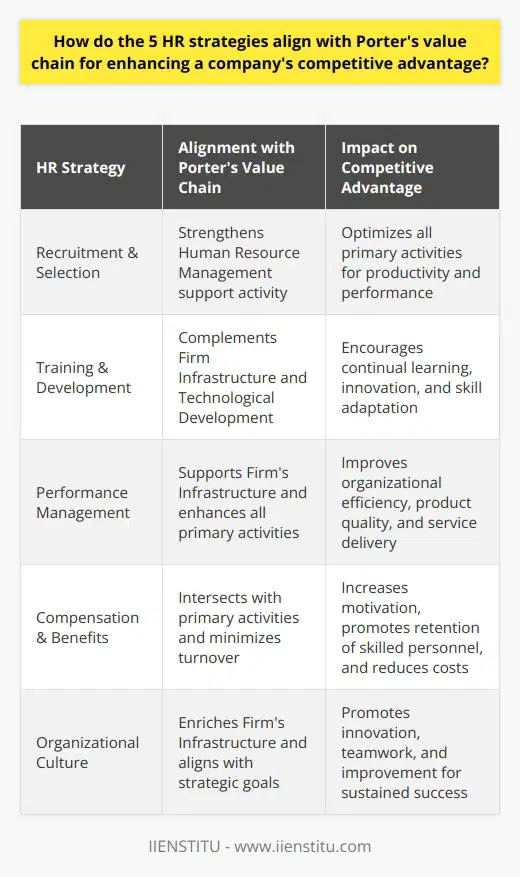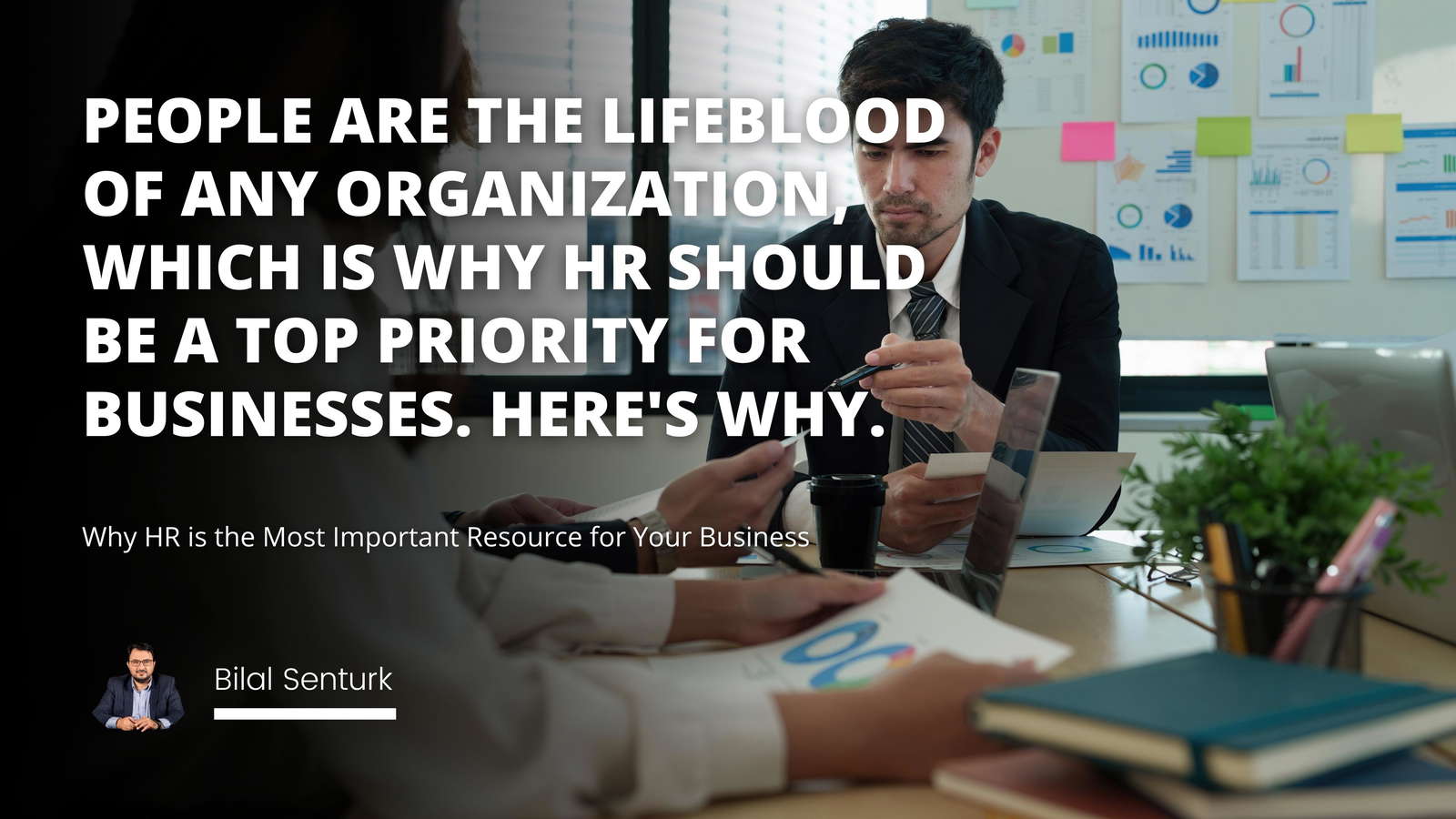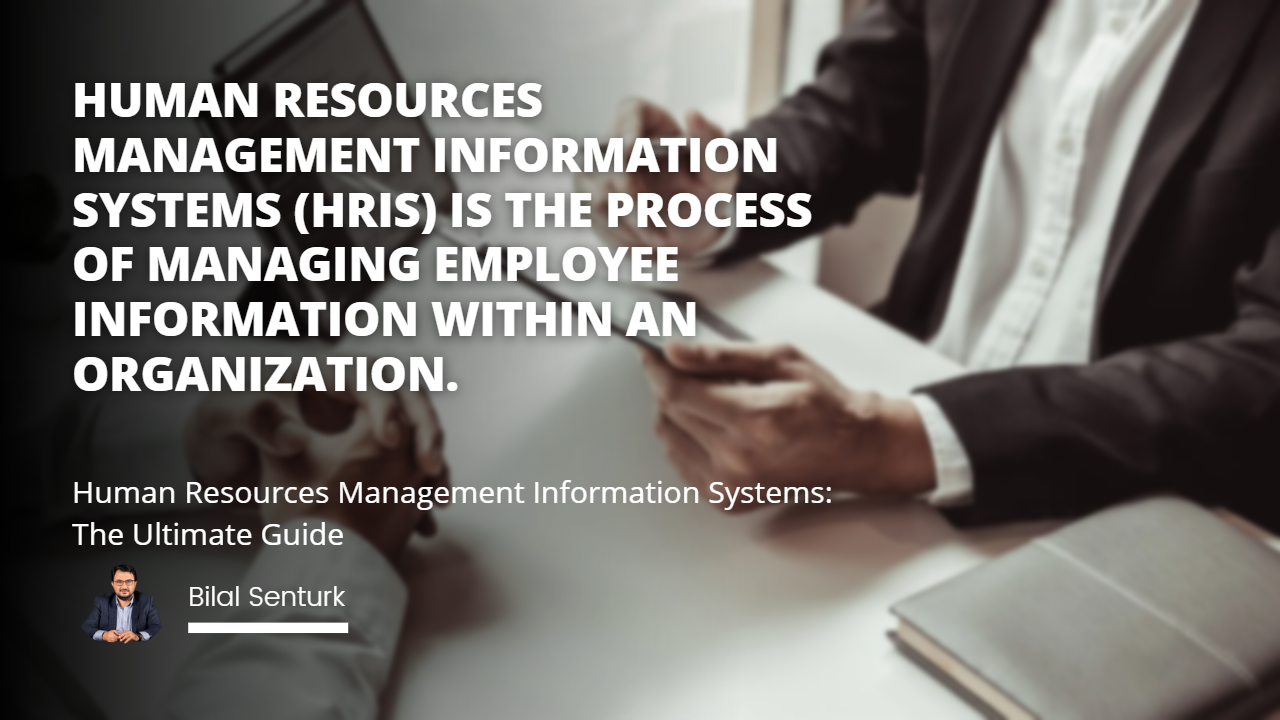
The 1990s, the introduction of Human Resources Information Systems (HRIS), and the development of new recruitment methods have all been essential developments in HR.
Introduction to Human Resources
The 1980s: EEO and Affirmative Action
The 1990s: Expansion of EEO Responsibilities
Human Resources Information System
Recruitment Methods
Human Resources: An Overview
Human resources (HR) is a term used to refer to the function or department responsible for managing personnel within an organization. This term has largely replaced the term “personnel” as it reflects a more proactive approach to managing people to maximize their potential.
Throughout the 1980s and 1990s, HR has increasingly become an essential function in any work setting, with its responsibilities expanding to cover various areas. This article outlines the key developments in HR over the last four decades, including equal employment opportunity (EEO) and affirmative action in the 1980s, the expansion of EEO responsibilities in the 1990s, the introduction of Human Resources Information Systems (HRIS), and recruitment methods.
The 1980s saw the emergence of EEO and affirmative action as the primary responsibilities of HR. EEO is a legal framework that prohibits discrimination in the workplace based on race, color, religion, sex, national origin, age, disability, or genetic information. Affirmative action, meanwhile, is a set of policies and practices designed to ensure that all employees are treated fairly and given equal opportunities for advancement. Introducing these policies and practices was an essential step in ensuring that all employees were respected and given equal opportunities, regardless of their characteristics.
In the 1990s, the responsibilities of HR expanded to cover a broader range of areas. This included organizational development, career planning, employee grievances, and disciplinary proceedings. HR also began to take on a more significant role in an organization's strategic planning to ensure that the organization was able to meet its goals and objectives. Additionally, HR began to take on a more proactive role in managing personnel to make the most of the potential of its employees.
The introduction of Human Resources Information Systems (HRIS) in the 1990s was also a significant development in HR. HRIS is an electronic filing system that stores and provides access to employee information, such as job descriptions, performance reviews, and salary information. It also allows managers to track employee performance, analyze trends, and identify areas for improvement.
Finally, recruitment methods have also changed significantly over the last four decades. In the past, recruitment was done mainly through newspaper advertisements or word of mouth. However, in the modern era, recruitment is often done through online job postings, social media, and recruitment agencies. Additionally, employers are increasingly using psychometric testing and other methods to ensure they select suitable candidates for the job.
In conclusion, HR has come a long way over the last four decades. The introduction of EEO and affirmative action in the 1980s, the expansion of EEO responsibilities in the 1990s, the introduction of HRIS, and the changes to recruitment methods have significantly impacted how HR is managed. As the role of HR continues to evolve, it is essential to ensure that the right policies and practices are in place to ensure that all employees are treated fairly and given equal opportunities.
People are the greatest asset of any organization; effective Human Resources Management is the key to unlocking their potential.

Frequently Asked Questions
What strategies can be used to effectively harness the potential of Human Resources Management?
Human Resources Management is a critical component of any organization's success. It is crucial to ensure that the organization has the right people, in the right roles, at the right time to achieve its goals and objectives. To effectively harness the potential of Human Resources Management, organizations should consider a variety of strategies.
One strategy is ensuring that the organization has a comprehensive Human Resources Management strategy. This strategy should address all aspects of Human Resources Management, including recruitment, retention, training, and development. It should also include a clear set of objectives and goals the organization seeks to achieve. This will help ensure that the organization is focused on meeting its goals and objectives and that the Human Resources Management team is working toward them.
Another strategy is ensuring that the organization has an effective Human Resources Management system. This system should be designed to track the progress of each employee's progress and provide feedback on their performance. It should also provide information on the organization's performance so that the Human Resources Management team can make necessary adjustments to ensure that the organization meets its goals and objectives.
Finally, organizations should ensure that their Human Resources Management team is well-trained in Human Resources Management. This includes training on managing people properly and developing effective strategies to ensure that the organization is meeting its goals and objectives. This training should also include an understanding of the legal requirements and regulations governing Human Resources Management.
By implementing the above strategies, organizations can effectively harness the potential of Human Resources Management. This will help ensure that the organization has the right people, in the right roles, at the right time to achieve its goals and objectives. Additionally, it will help the organization ensure that its Human Resources Management team is well-trained and well-equipped to meet its goals and objectives.
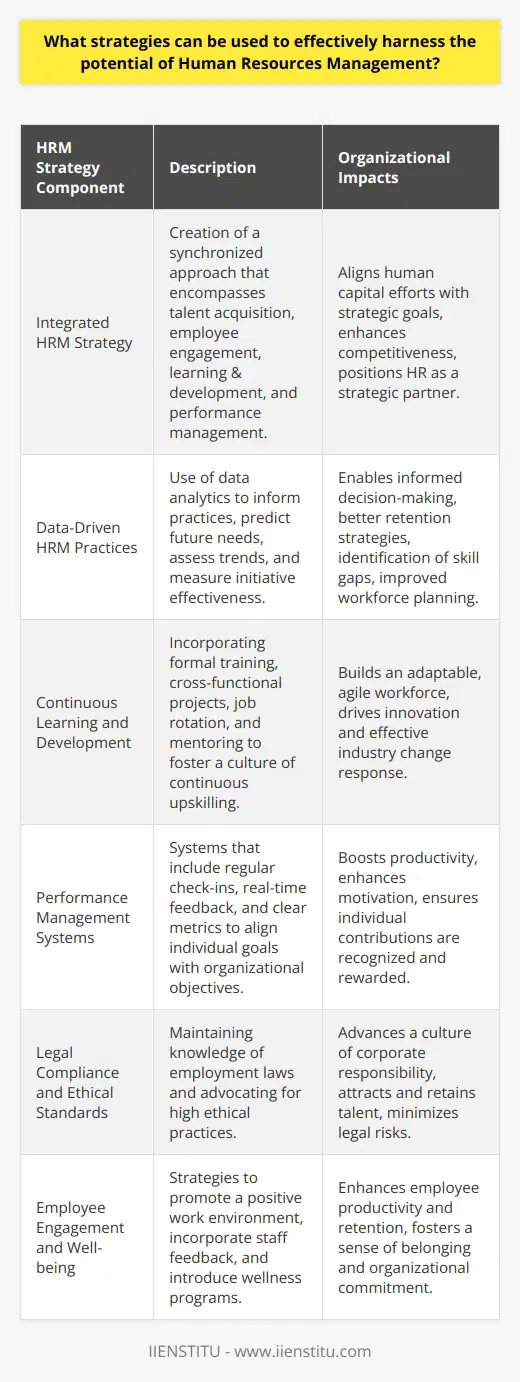
How can Human Resources Information Systems be used to improve the recruitment process?
Organizations today are increasingly looking for ways to improve the recruitment process and make it more efficient. Human Resources Information Systems (HRIS) effectively solve this challenge. HRIS are computer-based systems that enable organizations to manage their human resources more effectively. They can be used to improve the recruitment process by streamlining the process and reducing the time and resources required for recruiting new employees.
One of the main advantages of using HRIS for recruitment is that it simplifies the recruitment process by automating many administrative tasks. For example, HRIS can post job openings online, track applications, and automate the selection and hiring process. This reduces the time and resources required to recruit new employees, resulting in cost savings for the organization.
In addition, HRIS can be used to track applicants' progress throughout the recruitment process. This allows recruiters to quickly identify potential candidates, evaluate their skills and qualifications, and make informed decisions about who to hire. By using HRIS, recruiters can ensure they are selecting the right candidate for the job.
Finally, HRIS can be used to monitor the performance of new hires. This allows companies to measure the recruitment process's success and identify improvement areas. For example, HRIS can be used to track the number of days it takes to fill a position, identify areas where recruitment efforts are not successful, and measure the performance of new hires.
By using a Human Resources Information System to streamline the recruitment process, organizations can reduce costs and improve the quality of their recruitment efforts. Not only does this save time and resources, but it also increases the chances of finding the right candidate for the job.
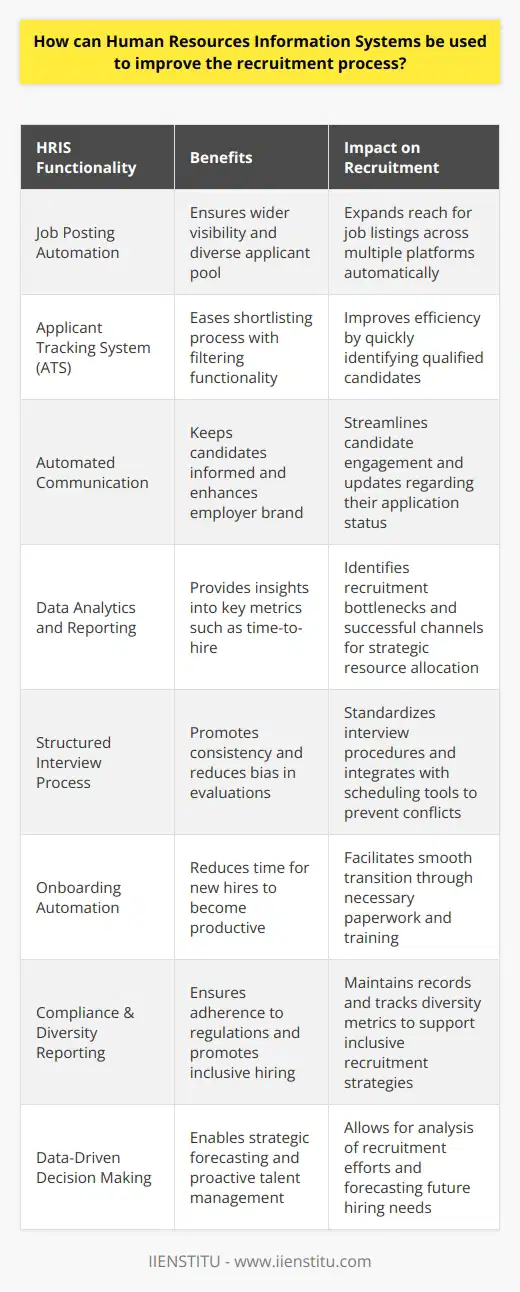
What are the benefits of implementing Equal Employment Opportunity and Affirmative Action policies in the workplace?
Equal Employment Opportunity (EEO) and Affirmative Action (AA) policies have been widely implemented in the workplace to create an environment of inclusion and fairness. These policies have been proven to have numerous benefits, both for individual employees and the organization as a whole.
One of the most significant benefits of implementing EEO and AA policies in the workplace is that it allows organizations to attract and retain a diverse workforce. Studies have shown that having a diverse workforce is associated with increased creativity and innovation, leading to increased productivity and profitability.
Additionally, by creating an inclusive and equitable atmosphere, organizations can increase employee engagement and satisfaction, leading to improved overall performance.
Another benefit of implementing EEO and AA policies in the workplace is that they can help to reduce instances of discrimination and harassment. Organizations can ensure that all employees feel safe and respected by creating a clear and comprehensive approach that outlines expectations and procedures for addressing violations.
Additionally, by providing resources and training to managers and supervisors, organizations can ensure that they can effectively address any issues of discrimination or harassment that may arise.
Last but not least, implementing EEO and AA workplace policies can help organizations avoid legal action. By creating and enforcing a comprehensive approach, organizations can demonstrate compliance with applicable laws and regulations, which can help to protect them from costly lawsuits.
In conclusion, implementing EEO and AA policies in the workplace is associated with numerous benefits for individual employees and the organization. By creating an inclusive and equitable atmosphere, organizations can ensure that all employees feel safe and respected.
Additionally, by providing resources and training to managers and supervisors, organizations can ensure that they can effectively address any issues of discrimination or harassment that may arise. Finally, by creating and enforcing a comprehensive policy, organizations can demonstrate compliance with applicable laws and regulations and avoid costly legal action.

What is the potential of HR in the context of organizational growth and development?
The Potential of HR in Organizational Growth and Development
Role of HR in Strategic Planning
The potential of Human Resources (HR) in the context of organizational growth and development is vast and multifaceted. HR contributes to strategic planning by aligning the organization's workforce and talent needs with its long-term objectives. This involves identifying skills gaps, forecasting demand for new roles, and formulating recruitment, training, and retention strategies to ensure that employees are both competent and engaged.
Talent Acquisition and Retention
HR plays a crucial role in talent acquisition and retention, critical factors in an organization's ability to grow and prosper. By adopting effective hiring practices, HR ensures that the organization attracts and retains the most talented individuals who fit its culture and values. This contributes to organizational growth by enhancing team cohesion, productivity, and overall engagement.
Employee Development and Training
Another key area where the potential of HR lies is in employee development and training. HR fosters organizational growth by identifying employees with high potential, equipping them with the necessary skills and competencies to take on increased responsibilities. HR professionals create and facilitate targeted training programs, leadership development initiatives, and career advancement plans, ensuring that employees are consistently honing their skills and increasing their value to the organization.
Performance Management and Evaluation
HR's role in performance management and evaluation is critical to organizational growth, as it enables the measurement and continuous improvement of individual and organizational performance. By implementing systems to monitor and evaluate employee performance, HR helps managers identify areas of strength and areas for development, ensuring that performance goals are met and driving the overall growth of the organization.
Promoting a Positive Work Culture
In addition to the more tangible factors mentioned above, the potential of HR lies in its ability to foster a positive work culture, which can contribute significantly to organizational growth and development. Research has repeatedly shown that high levels of employee engagement and satisfaction are correlated with increased productivity, customer satisfaction, and financial performance. By promoting a positive work environment, HR helps create the conditions necessary for employees to thrive and achieve their full potential.
In conclusion, the potential of HR in supporting organizational growth and development revolves around its many functions, including strategic planning, talent acquisition and retention, employee development and training, performance management and evaluation, and promoting a positive work culture. By embracing these responsibilities, HR plays a vital role in driving organizational growth and ensuring continued success.
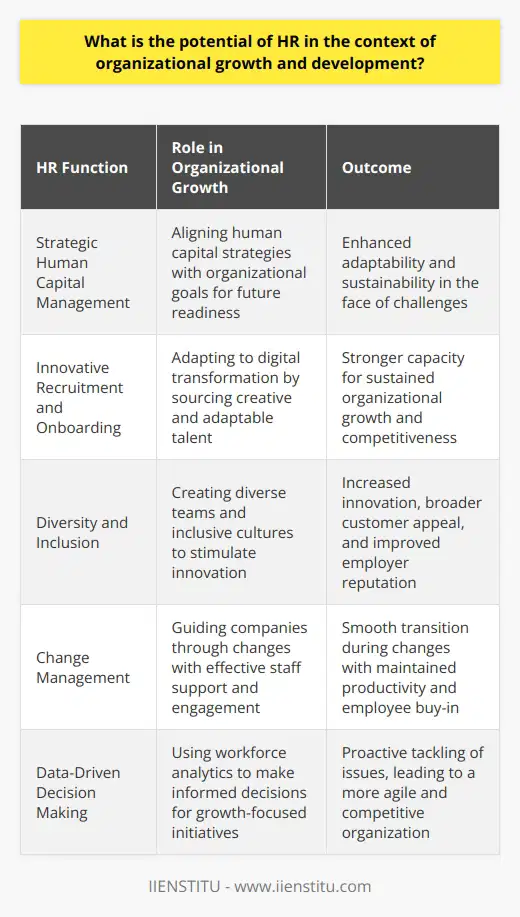
How do the 5 HR strategies contribute to the overall success of a company?
Significance of HR Strategies in a Company's Success
Strategic Human Resources Management
Effective human resources (HR) strategies play a fundamental role in the overall success of a company. First, strategic HR management includes aligning HR policies and practices with organizational goals. This ensures that employees' skills and abilities are deployed to achieve the desired business results, leading to heightened efficiency and a competitive advantage.
Talent Acquisition and Retention
Second, talent acquisition and retention strategies focus on attracting and retaining high-quality employees. Companies that excel in this area minimize employee turnover, reducing costs associated with hiring and training new employees. Furthermore, a strong talent pool aids in driving innovation and overall organizational performance.
Employee Development
Third, employee development strategies are essential for nurturing the skills and talents of the workforce. Providing opportunities for continuous learning and development ensures that employees remain up-to-date with industry trends and technologies. Consequently, a highly skilled workforce contributes significantly to a company's competitiveness, adaptability, and resilience in a dynamic market landscape.
Performance Management
Fourth, performance management strategies help in the evaluation and improvement of employees' outputs and outcomes. By setting clear objectives, providing regular feedback, and offering appropriate incentives, HR can motivate employees to perform at their best. This leads to increased productivity, heightened employee satisfaction, and ultimately, corporate success.
Workplace Culture Enhancement
Lastly, HR strategies that focus on enhancing workplace culture improve employee engagement, morale, and communication. A healthy work environment fosters collaboration, innovation, and continuous improvement. Employees who feel valued and appreciated are more likely to be committed and contribute positively to the company's success.
In conclusion, the five HR strategies - strategic HR management, talent acquisition and retention, employee development, performance management, and workplace culture enhancement - are crucial elements in fostering a company's overall success. By prioritizing these areas, organizations can maximize their human capital potential, leading to higher productivity, profitability, and long-term sustainability.

In what ways does human resource management impact Porter's value chain framework?
Human Resource Management's Role
Human resource management (HRM) significantly impacts Porter's value chain framework in various ways. As a critical component of the firm's internal operations, HRM influences the efficiency and effectiveness of each primary and support activity within the value chain.
Recruitment, Training, and Retention of Talent
One major aspect is the recruitment, training, and retention of talent. By attracting skilled employees and investing in their continued development, HRM enhances the firm's competitive advantage. HRM therefore directly contributes to the value chain by ensuring the proficiency and productivity of workers in performing primary activities such as inbound logistics, operations, outbound logistics, marketing and sales, and service.
Supporting Organizational Culture and Employee Engagement
Another significant element is the fostering of organizational culture and maximizing employee engagement. By cultivating a healthy work environment, HRM encourages high performance, innovation, and collaboration. These factors drive value creation and reinforce the efficiency of the value chain activities. A strong organizational culture also facilitates communication and knowledge sharing, which in turn maximizes the integration among value chain processes.
Performance Management and Compensation Systems
Additionally, HRM impacts the value chain through performance management and effective compensation systems. By setting clear expectations, providing regular feedback, and rewarding employees for their accomplishments, HRM promotes a motivated and results-oriented workforce. In this way, the human capital of a company becomes an essential driver of its competitive advantage, with HRM optimizing internal processes and operations.
Conclusion
In conclusion, human resource management plays a vital role in shaping the success of Porter's value chain framework. From recruiting and retaining talent to fostering a positive work culture and designing effective performance management systems, HRM's impact transcends primary and support activities, ultimately enabling firms to achieve a competitive advantage in their respective industries.

How do you maximize human resource potential through employee engagement and motivation?
Understanding Employee Needs
To maximize human resource potential through employee engagement and motivation, it is critical to identify and understand the needs and expectations of employees. This can be achieved through regular communication, feedback mechanisms, and performance evaluations. By connecting with employees and obtaining their insights, management can implement targeted strategies that align with those needs, fostering a positive work environment and ensuring job satisfaction.
Establishing a Reward System
A key component of employee motivation is the implementation of a suitable reward system that recognizes and celebrates the efforts and achievements of individuals and teams. This may include financial incentives, promotions, flexible work arrangements, or other benefits that reflect the values and preferences of the workforce. By offering a competitive and compelling reward package, organizations can effectively motivate employees to perform at their best and contribute to overall success.
Developing a Culture of Learning
Organizations should prioritize the cultivation of a learning and growth culture to boost employee engagement and motivation. This can be accomplished by providing continuous learning opportunities, investing in employee training, and promoting self-improvement initiatives. By fostering an environment where employees are encouraged to develop their skills and evolve professionally, companies can retain top talent, increasing productivity and fostering a strong sense of dedication to the organization.
Promoting Work-Life Balance
Another critical aspect of maximizing human resource potential is fostering a healthy work-life balance. Employers should encourage employees to strike a balance between work commitments and personal pursuits, such as hobbies and family time. This can be achieved by offering flexible hours, support for remote work, or organizing wellbeing programs. Empowering employees to take control of their personal and professional lives translates into higher engagement and dedication in the workplace.
Encouraging Collaboration and Teamwork
Employees feel more motivated and engaged when they work in an environment of collaboration and positive teamwork. Fostering a sense of belonging and camaraderie is essential to maximizing the potential of human resources. Companies should focus on creating an inclusive culture, promoting open communication, and encouraging employees to share their ideas and opinions. By facilitating strong collaboration and teamwork, organizations can benefit from the diverse skills and talents of the workforce, while maintaining high levels of motivation among employees.
In conclusion, maximizing human resource potential through employee engagement and motivation requires an understanding of employee needs, a competitive reward system, a culture of learning, healthy work-life balance, and an environment of collaboration and teamwork. Together, these strategies create an ideal workplace that effectively attracts, retains, and motivates top talent, driving organizational success.
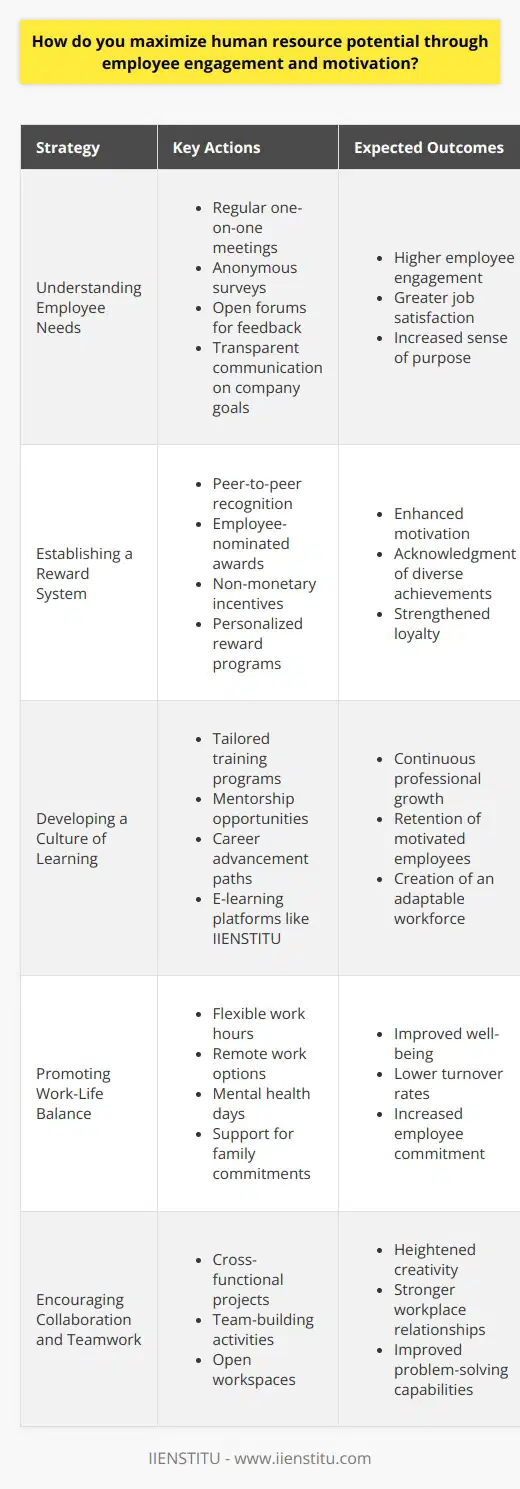
What is the role of human resource management in driving innovation within an organization?
Role of HRM in Innovation
Human resource management (HRM) plays a critical role in fostering innovation within organizations. By implementing effective recruitment strategies, HRM ensures the organization has a talented workforce with diverse skill sets and ideas, which contribute to the development of innovative products and services.
Enhancing Employee Creativity
One of HRM's responsibilities is to provide an environment that encourages employees to generate original ideas. This includes offering training and development programs that enable employees to develop creative problem-solving skills essential for innovation.
Incentivizing Innovative Behavior
HRM designs compensation and reward systems that recognize and incentivize innovative behavior. These motivation schemes stimulate employees to think creatively, take calculated risks, and develop innovative solutions. By rewarding employees for their creativity, HRM drives innovation.
Promoting Collaboration and Teamwork
Innovation often arises from effective collaboration and teamwork. HRM cultivates a culture that values open communication, trust, and teamwork, as these elements foster the exchange of ideas necessary for innovation.
Encouraging Cross-Functional Cooperation
HRM facilitates cross-functional cooperation by ensuring diverse teams work together on projects. This interaction leads to the synthesis of ideas from different perspectives, thereby generating innovative outcomes.
Managing Change
Organizations must adapt to changes in their internal and external environments to stay competitive. HRM plays a vital role in managing change, ensuring that employees are aligned with the organization's goals, and leading the transformation required to foster a culture of innovation.
Nurturing an Innovative Culture
Lastly, HRM nurtures an innovative culture by promoting the values and attitudes that support innovation. HR establishes a flexible structure that encourages experimentation, nurtures new ideas, and supports employee autonomy, thus driving innovation in organizations.
In conclusion, human resource management is integral to driving innovation within organizations. By recruiting talented employees, promoting collaboration and teamwork, incentivizing innovative behavior, managing change, and nurturing an innovative culture, HRM plays a critical role in the growth and success of an organization.
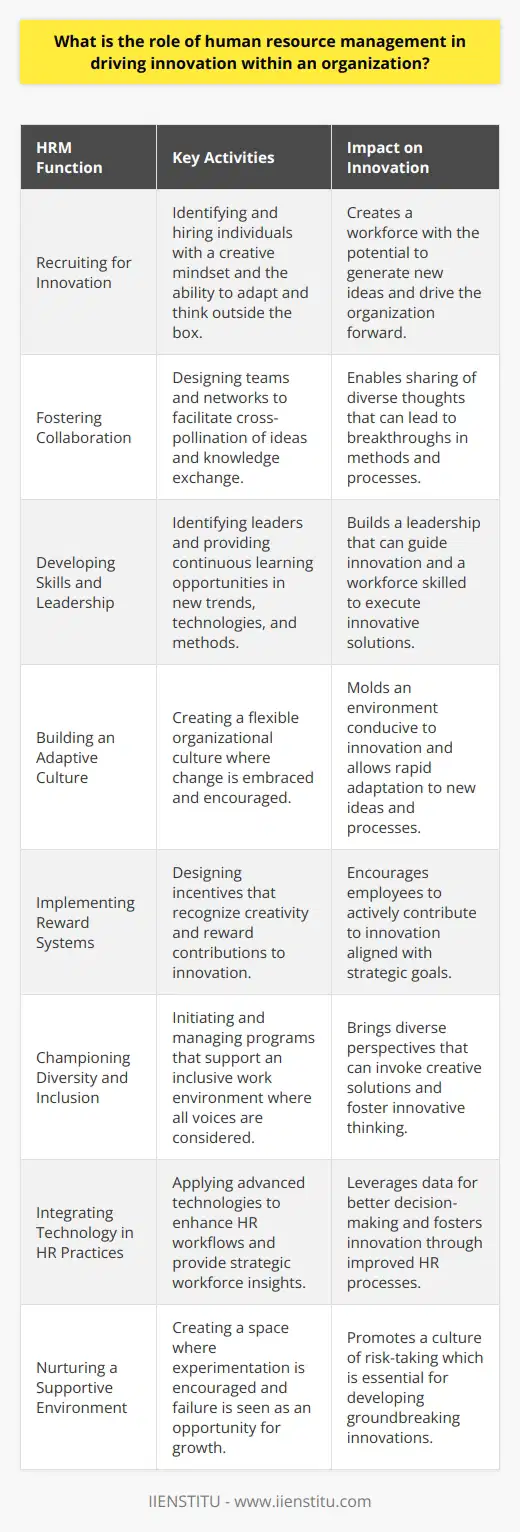
How do the 5 HR strategies align with Porter's value chain for enhancing a company's competitive advantage?
Integrating HR Strategies with Porter's Value Chain
Understanding Porter's Value Chain
To analyze the alignment of the five human resources (HR) strategies with Porter's value chain for enhancing a company's competitive advantage, it is essential first to understand the concept of the value chain. Porter's value chain comprises a set of activities performed by a company that add value to its products or services. These activities are divided into primary (e.g., inbound logistics, operations, outbound logistics, marketing, and sales) and support (e.g., procurement, technology development, human resource management, and infrastructure) components.
Recruitment and Selection Strategy
The recruitment and selection strategy aligns with the value chain by ensuring the right talent is attracted and retained for critical roles within the company. As a support activity, effective recruitment and selection contribute to the success of primary functions, improving overall productivity and providing the company with a competitive advantage.
Training and Development Strategy
Training and development programs within an organization are crucial in equipping employees with relevant skills and knowledge, enabling them to perform their tasks efficiently. The alignment of this HR strategy with the value chain is evident in how it supports technological development and human resource management, ultimately enhancing the quality, efficiency, and effectiveness of primary activities.
Performance Management Strategy
Performance management strategies involve setting goals, monitoring employee performance, and providing feedback. Integration with the value chain is apparent in how it supports primary activities such as operations, marketing, and sales. By driving employee engagement, motivation, and productivity, the performance management strategy allows companies to achieve a higher level of performance and gain a competitive edge in the market.
Compensation and Benefits Strategy
A comprehensive compensation and benefits strategy supports the value chain by attracting and retaining top talent, crucial for driving the success of primary activities. An attractive benefits package incentivizes employees to perform at their best, contributing to the company's overall competitive advantage in terms of quality, cost management, and innovation.
Organizational Culture Strategy
An organization's culture, encompassing its values, beliefs, and norms, plays a pivotal role in shaping employee behavior and performance. By fostering a culture that supports innovation, collaboration, and continuous improvement, companies can enhance the efficiency and effectiveness of their primary and support activities within the value chain, ultimately leading to a sustainable competitive advantage.
In summary, proper HR strategies integration with Porter's value chain framework is essential to maximize the value creation potential of an organization, resulting in enhanced competitive advantage and overall organizational success. By focusing on these aligned strategies, companies can optimize their human capital, invest in the development of their employees, and promote a high-performance culture that drives long-term results.
